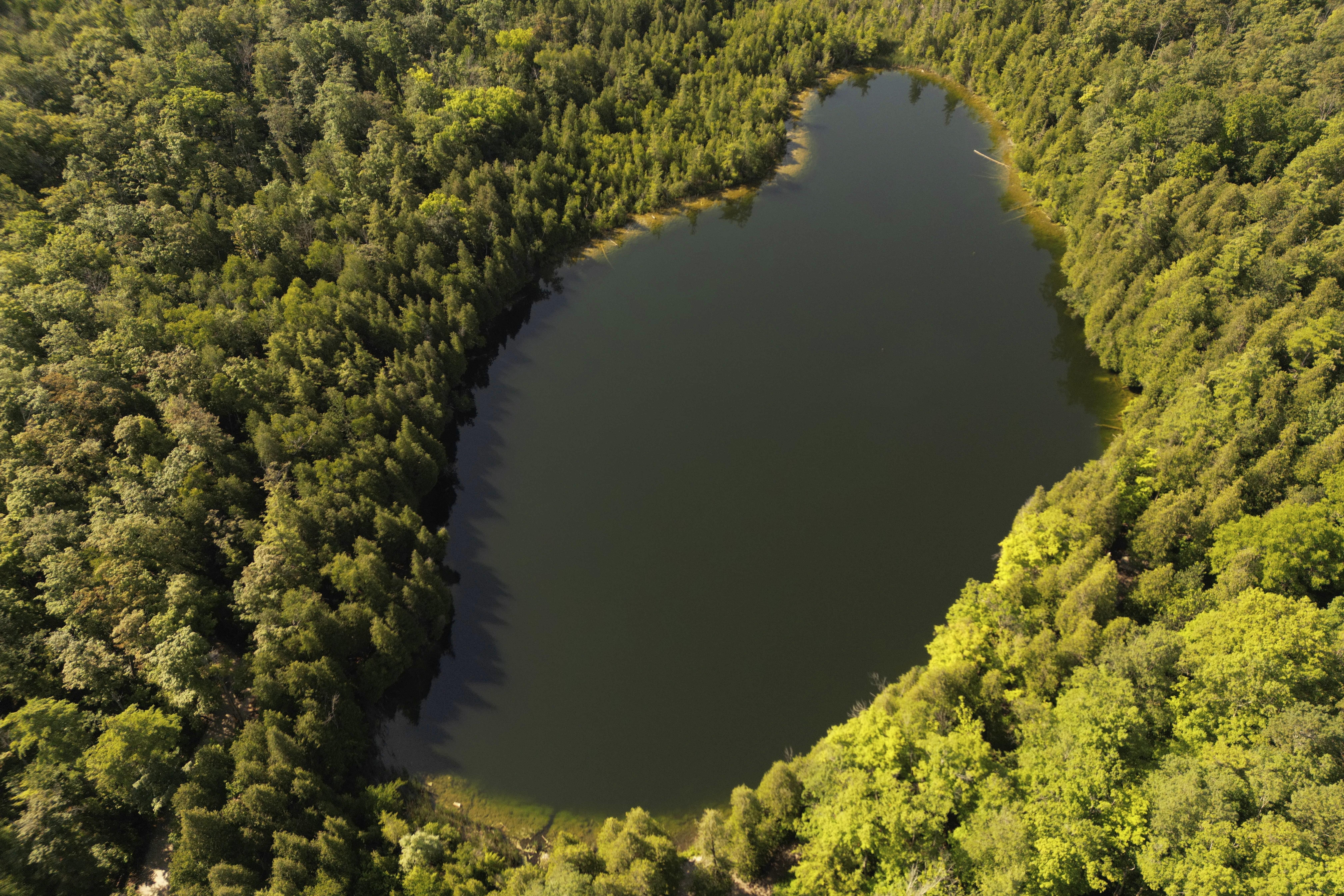 Trees surround Crawford Lake in Milton, Ontario, on July 10, 2023. (PHOTO / THE CANADIAN PRESS VIA AP)
Trees surround Crawford Lake in Milton, Ontario, on July 10, 2023. (PHOTO / THE CANADIAN PRESS VIA AP)
Sediment deposited at Crawford Lake, a small but deep body of water in Canada's Ontario province, provides unmistakable evidence that Earth entered a new human-driven geological chapter - the Anthropocene epoch - some seven decades ago, a team of scientists said on Tuesday.
The members of the Anthropocene Working Group (AWG) plan to submit the evidence to the international scientific body responsible for naming geological chapters in Earth's history. The scientists conducted research at a dozen sites worldwide and cited Crawford Lake, near Toronto, as the location that provided particularly persuasive geological markers that the Anthropocene epoch - essentially the age of humans - has arrived.
Plutonium from nuclear weapons testing in the 1950s provided "a very clear marker" for the transition to the Anthropocene and was accompanied by a surge in fossil fuel and fertilizer consumption, profound changes in land use and a decline in biodiversity caused by farming, said AWG chair Colin Waters, a professor at the University of Leicester in Britain.
 People look out at the water at Crawford Lake in Milton, Ontario, on July 7, 2023. (PHOTO / THE CANADIAN PRESS VIA AP)
People look out at the water at Crawford Lake in Milton, Ontario, on July 7, 2023. (PHOTO / THE CANADIAN PRESS VIA AP)
Crawford Lake sediments provided a record of accelerating changes that have unfolded in the past few decades, including traces of fly ash produced by burning fossil fuels
Presence of plutonium and other evidence was found in core samples of the Crawford Lake sediments.
"At present, we've had 70 years of the Anthropocene," Waters said. "That has been long enough, because of the rapidity of the change and the preciseness of it, to recognize that we've moved into this new Earth state, and that it should be defined by a new geological epoch."
The Anthropocene epoch is proposed as a chapter in Earth's history reflecting the transformation of the planet's climate and ecology as a result of human activity. But there has been disagreement within the scientific community about when this proposed epoch began and the evidence to demonstrate it.
ALSO READ: Diving into ancient history
The Anthropocene epoch has not yet been formally recognized by a scientific body called the International Commission on Stratigraphy. The Anthropocene, if it gains formal recognition, would follow the Holocene epoch, which began 11,700 years at the conclusion of the last Ice Age.
"Clearly the biology of the planet has changed abruptly," Waters added. "We cannot go back to a Holocene state now."
Layers of sediment deposited under bodies of water and other places can provide a record of changing environmental conditions over time. The scientists obtained core samples of sediment at Crawford Lake and sediments, soils, corals and ice samples at the other 11 sites.
 The sun shines on the water of Crawford Lake in Milton, Ontario, on July 7, 2023. (PHOTO / THE CANADIAN PRESS VIA AP)
The sun shines on the water of Crawford Lake in Milton, Ontario, on July 7, 2023. (PHOTO / THE CANADIAN PRESS VIA AP)
These radionuclides, particularly plutonium, effectively fingerprint the early 1950s in geological materials worldwide - in ultra-trace amounts - providing a radioactive marker that will persist for over 100,000 years.
Andrew Cundy, AWG member
The sediment at Crawford Lake, the scientists said, showed a "golden spike" illustrating a sudden - in geological terms - and irreversible shift in Earth's conditions. Such golden spikes - formally ending one geological chapter and ushering in another - would be observable in rock, glaciers or marine sediments for thousands of years to come.
"The record at Crawford Lake is representative of the changes that make the time since the mid-20th century geologically different from before, and worthy - we think - of the golden spike," said Francine McCarthy, an AWG member and professor of earth sciences at Brock University in Canada.
READ MORE: 'Ice Age humans likely migrated from China to Americas, Japan'
Crawford Lake sediments provided a record of accelerating changes that have unfolded in the past few decades, including traces of fly ash produced by burning fossil fuels. Shifts in the composition of the sediments also reflected a wide range of other human impacts including acid rain, global warming and biodiversity loss, the scientists said.
The precise time when the proposed epoch started remains contentious. Some suggest it began at the time of the Industrial Revolution of the 18th and 19th centuries or earlier. The AWG team said the more profound changes did not take place until the 1950s, when rapid economic and population growth drove up greenhouse gas emissions, and when radionuclides from weapons testing also infiltrated soils and sediments, coral, tree rings and glaciers.
ALSO READ: Geological analysis explains durability of Stonehenge megaliths
"These radionuclides, particularly plutonium, effectively fingerprint the early 1950s in geological materials worldwide - in ultra-trace amounts - providing a radioactive marker that will persist for over 100,000 years," said AWG member Andrew Cundy, a professor of environmental radioactivity at the University of Southampton in Britain.
The debate continues.
"I'm a little bit cynical about the exercise because it is like trying to pin an exact date on a process that has been playing out over a period of more than 50,000 years, probably more than 100,000, as humans have expanded across the planet," said Bill Laurance, a biologist at James Cook University in Australia.


